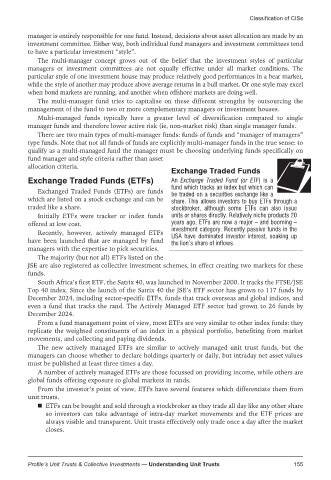Page 157 - Profile's Unit Trusts & Collective Investments - March 2025
P. 157
Classification of CISs
manager is entirely responsible for one fund. Instead, decisions about asset allocation are made by an
investment committee. Either way, both individual fund managers and investment committees tend
to have a particular investment “style”.
The multi-manager concept grows out of the belief that the investment styles of particular
managers or investment committees are not equally effective under all market conditions. The
particular style of one investment house may produce relatively good performances in a bear market,
while the style of another may produce above average returns in a bull market. Or one style may excel
when bond markets are running, and another when offshore markets are doing well.
The multi-manager fund tries to capitalise on these different strengths by outsourcing the
management of the fund to two or more complementary managers or investment houses.
Multi-managed funds typically have a greater level of diversification compared to single
manager funds and therefore lower active risk (ie, non-market risk) than single manager funds.
There are two main types of multi-manager funds: funds of funds and “manager of managers”
type funds. Note that not all funds of funds are explicitly multi-manager funds in the true sense: to
qualify as a multi-managed fund the manager must be choosing underlying funds specifically on
fund manager and style criteria rather than asset
allocation criteria.
Exchange Traded Funds
Exchange Traded Funds (ETFs) An Exchange Traded Fund (or ETF)isa
fund which tracks an index but which can
Exchanged Traded Funds (ETFs) are funds be traded on a securities exchange like a
which are listed on a stock exchange and can be share. This allows investors to buy ETFs through a
traded like a share. stockbroker, although some ETFs can also issue
Initially ETFs were tracker or index funds units or shares directly. Relatively niche products 20
offered at low cost. years ago, ETFs are now a major – and booming –
investment category. Recently passive funds in the
Recently, however, actively managed ETFs USA have dominated investor interest, soaking up
have been launched that are managed by fund
the lion’s share of inflows.
managers with the expertise to pick securities.
The majority (but not all) ETFs listed on the
JSE are also registered as collective investment schemes, in effect creating two markets for these
funds.
South Africa’s first ETF, the Satrix 40, was launched in November 2000. It tracks the FTSE/JSE
Top 40 index. Since the launch of the Satrix 40 the JSE’s ETF sector has grown to 117 funds by
December 2024, including sector-specific ETFs, funds that track overseas and global indices, and
even a fund that tracks the rand. The Actively Managed ETF sector had grown to 26 funds by
December 2024.
From a fund management point of view, most ETFs are very similar to other index funds: they
replicate the weighted constituents of an index in a physical portfolio, benefiting from market
movements, and collecting and paying dividends.
The new actively managed ETFs are similar to actively managed unit trust funds, but the
managers can choose whether to declare holdings quarterly or daily, but intraday net asset values
must be published at least three times a day.
A number of actively managed ETFs are those focussed on providing income, while others are
global funds offering exposure to global markets in rands.
From the investor’s point of view, ETFs have several features which differentiate them from
unit trusts.
ETFs can be bought and sold through a stockbroker as they trade all day like any other share
so investors can take advantage of intra-day market movements and the ETF prices are
always visible and transparent. Unit trusts effectively only trade once a day after the market
closes.
Profile’s Unit Trusts & Collective Investments — Understanding Unit Trusts 155

